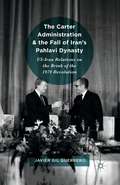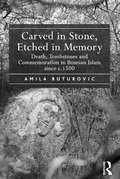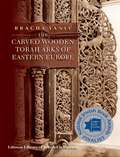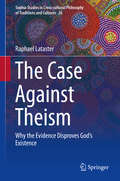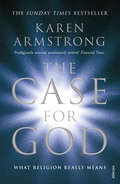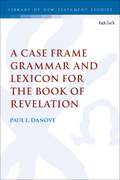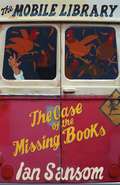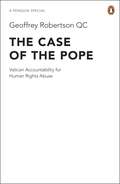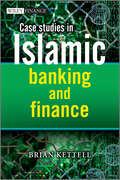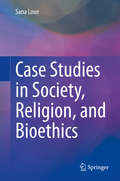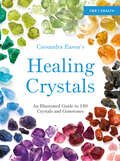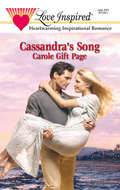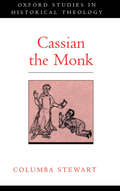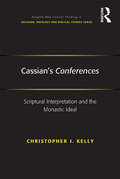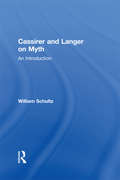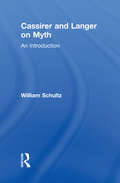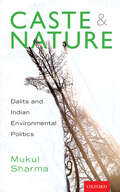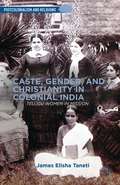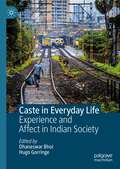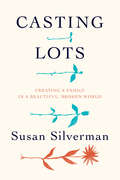- Table View
- List View
Carta sobre la tolerancia
by John Locke"La tolerancia de aquellos que disienten de otros en materia de religión se aviene tanto al Evangelio y a la razón que parece monstruoso que haya hombres tan ciegos en medio de una luz tan clara." LOCKE, John, Carta sobre la tolerancia. Locke es considerado el fundador del empirismo inglés y se estima que el Ensayo sobre el entendimiento humano(1690) es su obra capital. Pero no sólo fueron absorvidos sus esfuerzos en la teoría del conocimiento. También fue crucial su influencia en la filosofía política y en la teoría de la educación. La polémica desatada por su Carta sobre la tolerancia(1689) nos remite a un entorno sacudido por las luchas políticas y religiosas que, quizás, en algún momento, desesperaron a nuestro autor. Su antídoto es claro: la separación neta y radical entre Estado e Iglesia. Al primero le corresponde el velar por el bienestar de los ciudadanos; la Iglesia, por su parte, debe dedicarse al cuidado de las almas de sus fieles. Tolerancia en materia relgiosa y delimitación estricta del origen y funciones del poder político, establecidas en Dos tratados sobre el gobierno civil(1690). Por ellos se le colocará también en la cuna del liberalismo clásico.
The Carter Administration and the Fall of Iran’s Pahlavi Dynasty: US-Iran Relations on the Brink of the 1979 Revolution
by Javier Gil GuerreroThis book is a tale of loss: the loss of Iran as America's main ally and agent in the Middle East and the downfall of the short-lived Pahlavi monarchy and America's inability and unwillingness to prevent its demise. Khomeini's triumph altered America's perception of Islam and fundamentally changed its relationship with Iran.
Carved in Stone, Etched in Memory: Death, Tombstones and Commemoration in Bosnian Islam since c.1500
by Amila ButurovicDespite the recent history of violence and destruction, Bosnia-Herzegovina holds a positive place in history, marked by a continuous interweaving of different religious cultures. The most expansive period in that regard is the Ottoman rule that lasted here nearly five centuries. As many Bosnians accepted Islam, the process of Islamization took on different directions and meanings, only some of which are recorded in the official documents. This book underscores the importance of material culture, specifically gravestones, funerary inscriptions and images, in tracing and understanding more subtle changes in Bosnia’s religious landscape and the complex cultural shifts and exchange between Christianity and Islam in this area. Gravestones are seen as cultural spaces that inscribe memory, history, and heritage in addition to being texts that display, in image and word, first-hand information about the deceased. In tackling these topics and ideas, the study is situated within several contextual, theoretical, and methodological frameworks. Raising questions about religious identity, history, and memory, the study unpacks the cultural and historical value of gravestones and other funerary markers and bolsters their importance in understanding the region’s complexity and improving its visibility in global discussions around multiculturalism and religious pluralism. Drawing upon several disciplinary methods, the book has much to offer anyone looking for a better understanding of the intersection of Christianity and Islam, as well as those with an interest in death studies.
Carved in Stone, Etched in Memory: Death, Tombstones and Commemoration in Bosnian Islam since c.1500
by Amila ButurovicDespite the recent history of violence and destruction, Bosnia-Herzegovina holds a positive place in history, marked by a continuous interweaving of different religious cultures. The most expansive period in that regard is the Ottoman rule that lasted here nearly five centuries. As many Bosnians accepted Islam, the process of Islamization took on different directions and meanings, only some of which are recorded in the official documents. This book underscores the importance of material culture, specifically gravestones, funerary inscriptions and images, in tracing and understanding more subtle changes in Bosnia’s religious landscape and the complex cultural shifts and exchange between Christianity and Islam in this area. Gravestones are seen as cultural spaces that inscribe memory, history, and heritage in addition to being texts that display, in image and word, first-hand information about the deceased. In tackling these topics and ideas, the study is situated within several contextual, theoretical, and methodological frameworks. Raising questions about religious identity, history, and memory, the study unpacks the cultural and historical value of gravestones and other funerary markers and bolsters their importance in understanding the region’s complexity and improving its visibility in global discussions around multiculturalism and religious pluralism. Drawing upon several disciplinary methods, the book has much to offer anyone looking for a better understanding of the intersection of Christianity and Islam, as well as those with an interest in death studies.
The Carved Wooden Torah Arks of Eastern Europe (The Littman Library of Jewish Civilization)
by Bracha YanivNational Jewish Book Awards Finalist for the Visual Arts Award, 2017. The carved wooden Torah arks found in eastern Europe from the seventeenth to nineteenth centuries were magnificent structures, unparalleled in their beauty and mystical significance. The work of Jewish artisans, they dominated the synagogues of numerous towns both large and small throughout the former Polish-Lithuanian Commonwealth, inspiring worshippers with their monumental scale and intricate motifs. Virtually none of these superb pieces survived the devastation of the two world wars. Bracha Yaniv’s pioneering work therefore breathes new life into a lost genre, making it accessible to scholars and students of Jewish art, Jewish heritage, and religious art more generally. Making use of hundreds of pre-war photographs housed in local archives, she develops a vivid portrait of the history and artistic development of these arks, the scope and depth of her meticulous research successfully compensating for the absence of physical remains. In this way she has succeeded in producing a richly illustrated and comprehensive overview of a classic Jewish religious art form. Professor Yaniv’s analysis of the historical context in which these arks emerged includes a broad survey of the traditions that characterized the local workshops of Lithuania, Belarus, and Ukraine. She also provides a detailed analysis of the motifs carved into the Torah arks and explains their mystical significance, among them representations of Temple imagery and messianic themes—and even daring visual metaphors for God. Fourteen arks are discussed in particular detail, with full supporting documentation; appendices relating to the inscriptions on the arks and to the artisans’ names will further facilitate future research. This seminal work throws new light on long-forgotten traditions of Jewish craftsmanship and religious understanding.
The Case Against Theism: Why the Evidence Disproves God’s Existence (Sophia Studies in Cross-cultural Philosophy of Traditions and Cultures #26)
by Raphael LatasterThis monograph offers a critique of arguments for the existence of a specifically Christian God advanced by prominent scholar William Lane Craig. The discussion incorporates philosophical, mathematical, scientific, historical, and sociological approaches. The author does not seek to criticize religion in general, or Christianity specifically. Rather, he examines the modern and relatively sophisticated evidential case for Christian theism. Scholars have been arguing for theism or naturalism for centuries, and there seems little to add to the discussion, especially from the theistic side. However, to assume that either theism or naturalism obtains is a false dichotomy. There are alternatives to both that merit consideration. Employing a probabilistic approach, the author advances this discussion. His work uniquely utilizes not only naturalistic hypotheses to argue against theism. It also presents supernaturalistic hypotheses. This leaves no question that theism is almost certainly false, even if some form of divine reality exists. This project seeks not to argue that Christianity or any other faith or religion is undesirable, but only to critically examine evidentialist claims posited by Christianity’s learned apologists. In fact, a major secondary aim is to consider alternative god-conceptions, such as polytheism and pantheism. This work aims to highlight that Christian theism is often granted special privileges by theistic philosophers of religion, which seems doubly inappropriate when certain alternative god-conceptions may even prove to be more plausible.
The Case for God: What religion really means
by Karen ArmstrongThere is widespread confusion about the nature of religious truth. For the first time in history, a significantly large number of people want nothing to do with God. Militant atheists preach a gospel of godlessness with the zeal of missionaries and find an eager audience. Tracing the history of faith from the Palaeolithic Age to the present, Karen Armstrong shows that meaning of words such as 'belief', 'faith', and 'mystery' has been entirely altered, so that atheists and theists alike now think and speak about God - and, indeed, reason itself - in a way that our ancestors would have found astonishing.Does God have a future? Karen Armstrong examines how we can build a faith that speaks to the needs of our troubled and dangerously polarised world.
A Case Frame Grammar and Lexicon for the Book of Revelation (The Library of New Testament Studies #666)
by Paul L. DanovePaul Danove presents a case frame grammar and lexicon for the Book of Revelation, with three major goals. He first provides a step-by-step introduction to case frame analysis, incorporating various adaptations and extensions to address the needs of the study of the Greek of the New Testament. He then supplies a comprehensive case frame grammar and description of the syntactic, semantic, and lexical requirements that each predicator imposes on its complements. He finally generates a case frame lexicon that guides the interpretation and translation of each predicator occurrence in its grammatical contexts.Danove begins with the method of analysis and description, with an overview of case frame grammar, an analysis of the events grammaticalized by the predicators in the Book of Revelation, descriptions of the usages of these events, and further specification of these descriptions. He then provides illustrative examples of the predicators with each usage, discusses the distinctive grammatical characteristics of Revelation, sets forth the protocols for generating lexicon entries, and concludes with the case frame lexicon for predicators in the text of Revelation.
A Case Frame Grammar and Lexicon for the Book of Revelation (The Library of New Testament Studies #666)
by Paul L. DanovePaul Danove presents a case frame grammar and lexicon for the Book of Revelation, with three major goals. He first provides a step-by-step introduction to case frame analysis, incorporating various adaptations and extensions to address the needs of the study of the Greek of the New Testament. He then supplies a comprehensive case frame grammar and description of the syntactic, semantic, and lexical requirements that each predicator imposes on its complements. He finally generates a case frame lexicon that guides the interpretation and translation of each predicator occurrence in its grammatical contexts.Danove begins with the method of analysis and description, with an overview of case frame grammar, an analysis of the events grammaticalized by the predicators in the Book of Revelation, descriptions of the usages of these events, and further specification of these descriptions. He then provides illustrative examples of the predicators with each usage, discusses the distinctive grammatical characteristics of Revelation, sets forth the protocols for generating lexicon entries, and concludes with the case frame lexicon for predicators in the text of Revelation.
The Case of the Missing Books (The Mobile Library #1)
by Ian SansomIntroducing Israel Armstrong, one of literature’s most unlikely detectives in the first of a series of novels from the author of the critically acclaimed Ring Road.
The Case of the Pope: Vatican Accountability for Human Rights Abuse
by Geoffrey Robertson QcTHE CASE OF THE POPE delivers a devastating indictment of the way the Vatican has run a secret legal system that shields paedophile priests from criminal trial around the world.Is the Pope morally or legally responsible for the negligence that has allowed so many terrible crimes to go unpunished? Should he and his seat of power, the Holy See, continue to enjoy an immunity that places them above the law?Geoffrey Robertson QC, a distinguished human rights lawyer and judge, evinces a deep respect for the good works of Catholics and their church. But, he argues, unless Pope Benedict XVI can divest himself of the beguilements of statehood and devotion to obsolescent canon law, the Vatican will remain a serious enemy to the advance of human rights.
Case Studies in Islamic Banking and Finance (The Wiley Finance Series #593)
by Brian KettellCase Studies in Islamic Banking and Finance is a pioneering resource that provides practical insights into the real world of Islamic financial transactions, and illustrates the complexities of this rapidly growing mode of modern finance. Based around 12 individual cases, the book stimulates discussion and develops the reader's understanding of Islamic finance by contrasting the theoretical concepts discussed in the author's companion text Introduction to Islamic Banking and Finance with practical real world situations. The cases cover core Islamic banking and finance topics including the Ijara, Mudaraba and Musharaka contracts; Islamic mortgages for home finance; leverage; and issues involved in opening an Islamic bank. Financial statement analysis for Islamic banks, the implications for fund management for equity investing and the impact of loan defaults on Islamic and conventional banks are also included. Each chapter concludes with a set of questions designed to test the reader's understanding of each case, with suggested solutions at the end of the book. This book is a must have resource for those wishing to apply their understanding of this complex subject and is an essential read for anyone seeking practical examples of how to apply the concepts in a real world environment.
Case Studies in Society, Religion, and Bioethics: (pdf)
by Sana LoueThis book explores, through case studies, the interplay between religion, culture, government, and politics in diverse societies on questions arising in the domain of bioethics. The case studies draw from multiple disciplinary perspectives, including history, theology, law, bioethics, public policy, science, and medicine. The text's global perspective permits a comparison of the differing approaches adopted by countries facing similar bioethical quandaries and the extent to which religion has or has not been instrumental in addressing such dilemmas. Secular and religious societies across the globe are being confronted with complex questions involving religious belief and the extent to which specific religious perspectives have in the past or should in the future be adopted as official policy. Bioethical issues involving the interplay of religion and government have become particularly notable in recent years. How these issues are resolved has major implications for individuals, healthcare providers, and the future of medical research and medical care. Topics explored among the chapters include: Homosexuality: Sin, Crime, Pathology, Identity, BehaviorMedical Error: Truthtelling, Apology, and ForgivenessRefusal of Medical TreatmentMedical Deportation Case Study: Nazism, Religion, and Human ExperimentationThe New Frontier: Cloning Case Studies in Society, Religion, and Bioethics will find an engaged audience among researchers and scholars in history, religion/theology, medicine, and bioethics interested in the influence of religion on bioethical decision-making. Students—particularly upper-level undergraduate and graduate students interested in bioethics, humanities, and theology—will find the text helpful in understanding the processes through which religion may serve as a basis for both societal policy and law and individual decision-making in health-related matters.
Case Studies in Spiritual Care: Healthcare Chaplaincy Assessments, Interventions and Outcomes
by Steve Nolan George Fitchett Paul Nash Andrew ToddThrough a rich variety of case studies, this book provides insight into the patient's needs and the chaplain's perspective, as well as discussions of spiritual assessments and spiritual care interventions. Case studies such as a request to baptise a child complicated due to his admission for 'psychiatric reasons', as well as work with military veterans, such as a female transgender veteran who has been alienated from her faith, show the breadth and complexity of work that chaplains undertake daily. Each section also includes critical responses to the case studies presented from a chaplain and related healthcare professional. This book will enable chaplains to critically reflect on the spiritual care they provide, and provide an informed perspective for healthcare professionals and others involved in chaplaincy services.
Cassandra Eason’s Illustrated Directory of Healing Crystals
by Cassandra EasonCassandra Eason's unique directory offers accessible information on more than 150 crystals.
Cassandra's Song (Steeple Hill Love Inspired Ser. #No. 141)
by Carole Gift PageA MATCH MADE IN HEAVEN?
Cassian the Monk (Oxford Studies in Historical Theology)
by Columba StewartThis book is a study of the life, monastic writings, and spiritual theology of John Cassian (c., 360-435). His Institutes and Conferences are a remarkable synthesis of earlier monastic traditions, especially those of fourth-century Egypt, informed throughout by Cassian's awareness of the particular needs of the Latin monastic movement he was helping to shape. Sometimes portrayed as simply an advocate of the sophisticated spiritual theology of Evagrius of Ponticus (360-435), Cassian was actually a theologian of keen insight, realism, and creativity. His teaching on sexuality is unique in early monastic literature in both its breadth and its depth, and his integration of biblical interpretation with the ways of prayer and teaching on ecstatic prayer are of fundamental importance for the western monastic tradition. The only Latin writer included in the classic Greek collections of monastic sayings, Cassian was the major spiritual influence on both the Rule of the Master and the Rule of Benedict, as well as the source for Gregory the Great's teaching on capital sins and compunction. Columba Stewart's book is the first major study of Cassian to be published in twenty years. It begins by establishing Cassian's credibility as a teacher on the basis of his own experience as a monk and his familiarity with the fundamental literary sources. Stewart then turns to Cassian's spiritual theology, paying particular attention to Cassian's view of the monastic journey in eschatological perspective, his teaching on continence and chastity, the Christological basis of biblical interpretation and prayer, his method of unceasing prayer, and his integration of ecstatic experience with an Evagrian theology of prayer.
Cassian's Conferences: Scriptural Interpretation and the Monastic Ideal (Routledge New Critical Thinking in Religion, Theology and Biblical Studies)
by Christopher J. KellyThis book explores Cassian's use of scripture in the Conferences, especially its biblical models to convey his understanding of the desert ideal to the monastic communities of Gaul. Cassian intended the scriptures and, implicitly, the Conferences to be the voices of authority and orthodoxy in the Gallic environment. He interprets familiar biblical characters in unfamiliar ways that exemplify his ideal. By imitating their actions the monk enters a seamless lineage of authority stretching back to Abraham. This book demonstrates how the scriptures functioned as a dynamic force in the lives of Christian monks in the fourth and fifth centuries, emphasizes the importance of Cassian in the development of the western monastic tradition, and offers an alternative to the sometimes problematic descriptions of patristic exegesis as "allegory" or "typology". Cassian has been described as little more than a provider of information about Egyptian monasticism, but a careful reading of his work reveals a sophisticated agenda to define and institutionalize orthodox monasticism in the Latin West.
Cassian's Conferences: Scriptural Interpretation and the Monastic Ideal (Routledge New Critical Thinking in Religion, Theology and Biblical Studies)
by Christopher J. KellyThis book explores Cassian's use of scripture in the Conferences, especially its biblical models to convey his understanding of the desert ideal to the monastic communities of Gaul. Cassian intended the scriptures and, implicitly, the Conferences to be the voices of authority and orthodoxy in the Gallic environment. He interprets familiar biblical characters in unfamiliar ways that exemplify his ideal. By imitating their actions the monk enters a seamless lineage of authority stretching back to Abraham. This book demonstrates how the scriptures functioned as a dynamic force in the lives of Christian monks in the fourth and fifth centuries, emphasizes the importance of Cassian in the development of the western monastic tradition, and offers an alternative to the sometimes problematic descriptions of patristic exegesis as "allegory" or "typology". Cassian has been described as little more than a provider of information about Egyptian monasticism, but a careful reading of his work reveals a sophisticated agenda to define and institutionalize orthodox monasticism in the Latin West.
Cassirer and Langer on Myth: An Introduction (Theorists of Myth)
by William SchultzFirst Published in 2000. Routledge is an imprint of Taylor & Francis, an informa company.
Cassirer and Langer on Myth: An Introduction (Theorists of Myth #12)
by William SchultzFirst Published in 2000. Routledge is an imprint of Taylor & Francis, an informa company.
Caste and nature: Dalits and Indian Environmental Policies
by Mukul SharmaRarely do Indian environmental discourses examine nature through the lens of caste. Whereas nature is considered as universal and inherent, caste is understood as a constructed historical and social entity. Mukul Sharma shows how caste and nature are intimately connected. He compares Dalit meanings of environment to ideas and practices of neo-Brahmanism and certain mainstreams of environmental thought. Showing how Dalit experiences of environment are ridden with metaphors of pollution, impurity, and dirt, the author is able to bring forth new dimensions on both environment and Dalits, without valourizing the latter’s standpoint. Rather than looking for a coherent understanding of their ecology, the book explores the diverse and rich intellectual resources of Dalits, such as movements, songs, myths, memories, and metaphors around nature. These reveal their quest to define themselves in caste-ridden nature and building a form of environmentalism free from the burdens of caste. The Dalits also pose a critical challenge to Indian environmentalism, which has, until now, marginalized such linkages between caste and nature.
Caste, Gender, and Christianity in Colonial India: Telugu Women in Mission (Postcolonialism and Religions)
by J. TanetiBeginning in the nineteenth century, native women preachers served and led nascent Protestant churches in much of Southern India, evolving their own mission theology and practices. This volume examines the impact of Telugu socio-political dynamics, such as caste, gender, and empire, on the theology and practices of the Telugu Biblewomen.
Caste in Everyday Life: Experience and Affect in Indian Society
by Dhaneswar Bhoi Hugo GorringeThis edited volume brings together a range of scholars to reflect on the varied ways in which caste is manifested and experienced in social life. Each chapter draws on different methods and approaches but all consider lived experiences and experiential narrations. Considering Guru and Sarukkai’s path-breaking work on ‘Experience, Caste and the Everyday Social’ (2019), this volume applies the insights of the theories to multiple settings, issues and communities. Unique to this volume, Brahmin and other dominant castes' experiences are considered, rather than simply focusing on the lives of oppressed castes (Dalits). Analysis of cross-caste friendships or romances and marriages, furthermore, brings out the intimate and ingrained aspects of caste. Taken together, therefore, the contributions in this volume offer rich insights into caste and its consciousness within the framework of everyday experiences.
Casting Lots: Creating a Family in a Beautiful, Broken World
by Susan SilvermanSusan Silverman grew up with parents who were, both before and after a devastating loss, atheists. Yet, as a young adult, she shocked everyone who knew her ("But you were elected Class Flirt in high school!") and became a rabbi. What was not surprising, however, was that she built her own big, unwieldy family through both birth and adoption, something she had intended from childhood. With three daughters and two sons ("We produce girls and import boys"), this unique family becomes a metaphor for the world's contradictions and complexities-a microcosm of the tragedy and joy, hope and despair, cruelty and compassion, predictability and absurdity of this world we all live in. A meditation on identity, faith, and belonging-one that's as funny as it is moving-Casting Lots will resonate with anyone who has struggled to find their place in the world and to understand the significance of that place.

